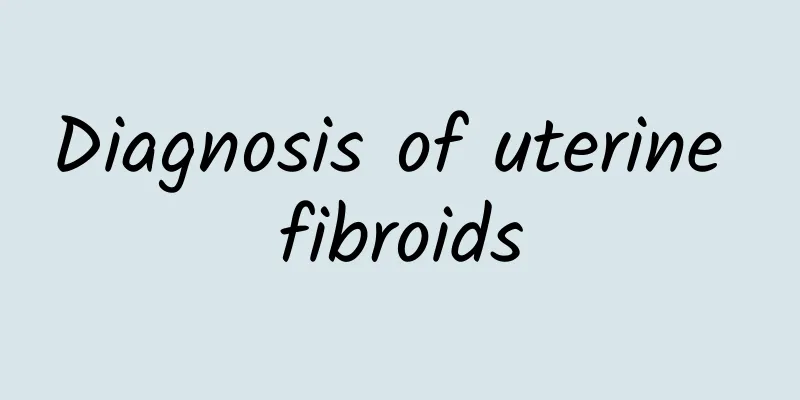Diagnosis of uterine fibroids

|
Uterine fibroids are a benign tumor. They are a common gynecological disease in women. How to diagnose and examine uterine fibroids? Let's learn about it together. Diagnostic tests for uterine fibroids: 1. Medical history Excessive or irregular menstrual bleeding, history of lower abdominal mass, etc. 2. Gynecological examination The uterus is found to be irregularly enlarged or uniformly enlarged. For example, a single or several hard nodular protrusions can be felt on the surface of the uterus for subserosal fibroids. Submucosal fibroids can sometimes dilate the cervix and touch the lower end of the fibroid in the uterine cavity through the cervix. If the fibroids are suspended in the vagina, the tumor body can be seen and its pedicle can be touched. 3. Auxiliary examination 1. Ultrasound examination At present, B-ultrasound examination is more common in China. The accuracy rate of identifying fibroids can reach 93.1%. It can show that the uterus is enlarged and irregular in shape; the number, location, size of fibroids, whether the fibroids are uniform or liquefied cystic, etc.; and whether the surrounding areas compress other organs. Due to the dense cells per unit volume of tumor cells in fibroid nodules, the content of connective tissue scaffold structure and the different arrangement of tumors and cells, the fibroid nodules show three basic changes when scanning: weak echo, equal echo and strong echo. The weak echo type has high cell density, high elastic fiber content, mainly nested arrangement of cells, and relatively rich blood vessels. The strong echo type has a high content of collagen fibers, and tumor cells are mainly arranged in bundles. The equal echo type is between the two. Posterior wall fibroids are sometimes unclear. The harder the fibroid, the heavier the attenuation performance, and the benign attenuation is more obvious than the malignant. When the fibroid degenerates, the acoustic penetration is enhanced. When the fibroid becomes malignant, the necrotic area increases and the echo inside is disordered. Therefore, B-ultrasound examination is helpful in diagnosing fibroids, providing a reference for distinguishing whether the fibroids are degenerating or becoming malignant, and it is also helpful in distinguishing ovarian tumors or other pelvic masses. 2. Use a probe to measure the uterine cavity Intramural fibroids or submucosal fibroids often enlarge and deform the uterine cavity, so a uterine probe can be used to detect the size and direction of the uterine cavity. Comparing it with the findings of a biphasic clinic can help determine the nature of the mass and understand whether there is a mass in the cavity and its location. However, it must be noted that the uterine cavity is often tortuous or blocked by submucosal fibroids, so that the probe cannot be fully inserted. Or if it is a subserosal fibroid, the uterine cavity often does not enlarge, which can lead to misdiagnosis. 3. X-ray film When the tumor is calcified, it appears as scattered consistent spots, or a shell-like calcified capsule, or a honeycomb with rough and wavy edges. 4. Diagnostic curettage Small submucosal fibroids or dysfunctional uterine bleeding, endometrial polyps are not easy to detect with bimanual examination, and curettage can be used to assist in diagnosis. In the case of submucosal fibroids, the curette feels a convex surface in the uterine cavity, which rises high at first and then slides down, or feels something sliding in the uterine cavity. However, curettage can scrape the tumor surface and cause bleeding, infection, necrosis, and even sepsis. Strict aseptic operation should be performed, the action should be gentle, and the scraped material should be sent for pathological examination. If submucosal fibroids are suspected but the diagnosis and curettage are still unclear, hysterography can be used. 5. Hysteroscopy Uterine fibroids are generally not difficult to diagnose. Small submucosal fibroids are usually difficult to diagnose clinically. Diagnostic curettage is often missed, but submucosal uterine fibroids are found in postoperative specimens of hysterectomy. Hysteroscopy can directly observe the nature of lesions in the uterine cavity, determine the location of the lesion, and accurately take biopsies. Small submucosal fibroids can also be removed at the same time. 6. Laparoscopy With the widespread application of laparoscopic technology in obstetrics and gynecology, laparoscopy is not only used as a means of examination, but is also often performed simultaneously with surgery, and is increasingly valued. Uterine fibroids can be clearly examined clinically and generally do not require laparoscopy. Some pelvic masses with surgical indications can be directly laparotomy. Occasionally, small solid masses are found next to the uterus, and it is difficult to determine their origin and nature, and their treatment methods are different. Especially when B-ultrasound examination is also difficult to determine, laparoscopy can be performed to clarify the diagnosis for treatment, such as small subserosal fibroids, ovarian tumors, tuberculous adnexal masses, etc. Laparoscopy should carefully observe the size, location, and relationship of pelvic fibroids with surrounding organs, and those who need surgery can immediately undergo surgical treatment. Therefore, when deciding to perform a laparoscopy, all preparations for possible surgery must be made. 7. CT and MRI Generally, these two tests are not necessary. The images of CT diagnosis of fibroids only express the details within a specific layer, and the image structures do not overlap. The CT image of benign uterine tumors is enlarged in volume, uniform in structure, and has a density of +40 to +60H (normal uterus is +40 to +50H). When MRI diagnoses fibroids, different signals are displayed for the presence or absence of degeneration, type, and degree of degeneration inside the fibroids. The myonuclei are not degenerated or slightly degenerated, and the internal signals are mostly uniform. On the contrary, those with obvious degeneration show different signals. 4. Self-examination of uterine fibroids 1. Observe the blood: Increased menstruation, postmenopausal bleeding or contact bleeding are often caused by tumors in the cervix or uterine body. Therefore, any bleeding other than normal menstruation must be investigated for its cause and treated accordingly. 2. Observation of leucorrhea: Normal leucorrhea is a small amount of slightly sticky, colorless and transparent secretion. It will change slightly with the menstrual cycle, but purulent, bloody, or watery leucorrhea is abnormal. 3. Feel for lumps by yourself: In the early morning, lie flat on the bed on an empty stomach, bend your knees slightly, relax your abdomen, and use both hands to touch the lower abdomen, from light to heavy. Larger lumps can be found. 4. Feeling of pain: Pay attention to pain in the lower abdomen, waist, back, or sacrum. What diseases are easily confused with uterine fibroids? As follows: 1. Pregnant uterus When uterine fibroids are complicated by cystic changes, they are easily misdiagnosed as a pregnant uterus. A pregnant uterus, especially in pregnant women over 40 years old, or those with bleeding after a miscarriage, may also be misdiagnosed as a uterine fibroid. In clinical practice, when encountering women of childbearing age with a history of amenorrhea, the possibility of pregnancy should be considered first. It is not difficult to confirm the diagnosis through B-type ultrasound examination or HCG measurement. If necessary, curettage should be performed for differentiation. Special attention should be paid to fibroids combined with pregnancy. At this time, the uterus is larger than the month of amenorrhea, the shape is often irregular, and the texture is harder. B-type ultrasound examination can help confirm the diagnosis. 2. Ovarian tumor Solid ovarian tumors may be misdiagnosed as subserosal myomas; conversely, cystic changes in subserosal myomas are often misdiagnosed as ovarian cysts. The differentiation is more difficult when the ovarian tumor is adhered to the uterus. B-type ultrasound examination can be performed, and sometimes a final diagnosis can only be made during laparotomy. 3. Uterine adenomyoma Clinically, it is also manifested as increased menstrual volume and enlarged uterus. The obvious difference from uterine fibroids is that dysmenorrhea is the main symptom. It is also common to diagnose uterine fibroids in patients with mild dysmenorrhea. During examination, the uterus is often uniformly enlarged, and has the characteristics of enlarging during menstruation and shrinking after menstruation. 4. Uterine hypertrophy The main clinical manifestations of this type of patients are also increased menstruation and enlarged uterus, so it is easy to be confused with uterine fibroids. However, in this disease, the uterus is uniformly enlarged and rarely exceeds a 2-month gestational uterus. B-mode ultrasound can assist in diagnosis. Uterine fibroids: http://www..com.cn/fuke/zgjl/ |
<<: Diagnosis of vulvar leukoplakia
>>: Treatment of uterine fibroids
Recommend
How to eat if you have cervical erosion
What should you eat if you have cervical erosion?...
What anti-inflammatory drugs are most effective for adnexitis?
There is no most effective anti-inflammatory drug...
Reverse fatty liver disease! Nutritionist: Avoid white rice and the "three whites"
One out of every 2 to 3 people in the country suf...
Can I have an abortion if I have uterine fibroids?
In life, many female friends do not take preventi...
Is pelvic peritonitis contagious?
If women experience lower abdominal pain and feve...
Prevent sarcopenia in old age! 2 strategies to maintain muscle mass and extend mobility
Many elderly people often feel that they have poo...
Eat refrigerator leftovers correctly to prevent liver disease! Nutritionist Wang Zinan: Follow the principle of "four no's and one freshness" to stay away from liver disease
The top ten causes of death in 2022 were announce...
Is left ovarian cyst serious?
Whether the left ovarian cyst is serious depends ...
Can menstruation resume after menopause? Pay attention to the 6 signs before menopause
Generally speaking, menopause is the beginning of...
Contraindications for medication during menstrual irregularities
Medication for irregular menstruation is generall...
What are the methods for treating cervical erosion?
Do you know the methods that women use to treat c...
Interpretation of the etiology of Trichomonas vaginitis from the perspective of traditional Chinese medicine
Among the many views on the causes of trichomonia...
What is the cause of non-menstrual bleeding?
What is the cause of non-menstrual bleeding? Non-...
What anti-inflammatory drugs should be taken for pelvic inflammatory disease? Different types have different symptoms
Patients with pelvic inflammatory disease will ha...
Should you eat less starch to lose weight? Is it easy to gain weight again if you don’t eat starch? Nutritionist Cheng Mingwei: Master 4 major techniques to lose weight with just the right amount of starch
There are many common myths about weight loss, su...









